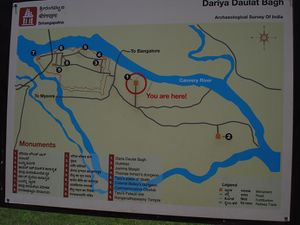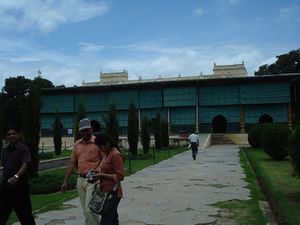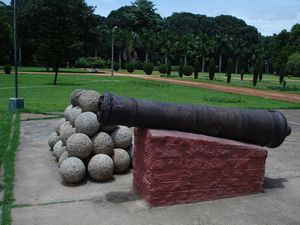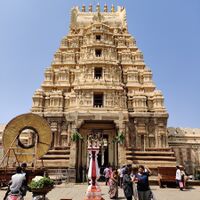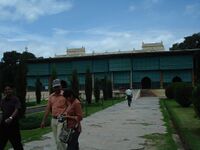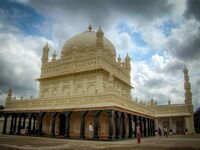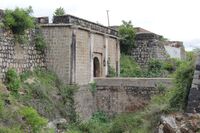Shrirangapattana
| Author:Laxman Burdak, IFS (R) |
Shrirangapattana (श्रीरंगपट्टन) is a town of Mandya district in the Indian State of Karnataka. Located near the city of Mysore, it is of religious, cultural and historic importance. The monuments on the island town of Srirangapatna has been nominated as a UNESCO World Heritage Site.
Contents
Variants
- Shrirangapattana श्रीरंगपट्टन, मैसूर, (AS, p.922)
- Srirangapatna
- Shrirangapattana
- Seringapatam
Location
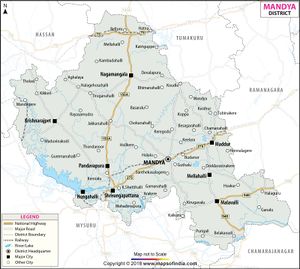
History
Srirangapatna became the capital of Mysore under Hyder Ali and Tipu Sultan.
The Treaty of Seringapatam (also called Srirangapatinam), signed 18 March 1792, ended the Third Anglo-Mysore War. Its signatories included Lord Cornwallis on behalf of the British East India Company, representatives of the Nizam of Hyderabad and the Maratha Empire, and Tipu Sultan, the ruler of Mysore.
Battle of Seringapatam, 1799: Srirangapatna was the scene of the last and decisive battle fought between Tipu Sultan and a combined force of 50,000 men provided equally by the Nizam of Hyderabad and the East India Company under the overall command of General George Harris. This battle was the last engagement of the Fourth Anglo-Mysore War. The Battle of Seringapatam, 1799, was truly momentous in its historic effects.
At the battle's climax, Tipu Sultan was killed within the fort of Seringapatam, betrayed by one of his own confidants; the spot where he ultimately fell is marked by a memorial. For the last time in history, Seringapatam had been the scene of political change in the Sultanate of Mysore. The joint forces of the victorious army proceeded to plunder Seringapatam and ransack Tipu's palace. Apart from the usual gold and cash, innumerable valuables and objets d'art, not excepting even the personal effects of Tipoo Sultan, his rich clothes and shoes, sword and firearms, were shipped to England.
While most of this is now to be found in the British Royal Collection and in the Victoria and Albert Museum, some articles have occasionally become available at auctions and have been retrieved for their native land. The sword of Tipu Sultan has been acquired by Vijay Mallya, a liquor baron from Karnataka, who purchased the same at a Sotheby's auction.
Much of the site of the Battle is still intact including the ramparts, the Water Gate, the place where the Tippu Sultan's body was found, the area where the British prisoners were held and the site of the destroyed palace.
Tipu's Tiger, an automaton now in the Victoria & Albert Museum, was captured at the battle.
Places of interest
Sri Ranganathaswamy Temple: The Ranganthaswamy Temple – usually referred to as "Sri Ranganathaswamy" – is dedicated to Ranganatha, a manifestation of Vishnu. It is one of the five important pilgrimage sites along the river Kaveri for devotees of Ranganatha. These five sacred sites are together known as Pancharanga Kshetrams in Southern India. Since Srirangapatna is the first temple starting from upstream, the deity is known as Adi Ranga (lit; "first Ranga"), and the town of Srirangapatna, which derives its name from the temple, is on an island in the river Kaveri.
Daria Daulat Bagh: The Dariya Daulat Palace (Summer Palace) is set amidst beautiful gardens called Daria Daulat Bagh. Tippu Sultan built this palace in 1784. The palace is built in the Indo-Saracenic style is mostly made of teakwood. The palace has a rectangular plan and is built on a raised platform.
Other attractions in Srirangapatna include the Jumma Masjid (a Mosque) and the Daria Daulat Gardens. The mosque has stone Arabic inscriptions which mention the 99 titles given to the Prophet Mohammed, and the Farsi inscriptions which mentions that the Jamia Masjid called Masjid-E-Ala was built in AD 1782 by Tipu Sultan.
Tipu Sultan Gumbaz: The Gumbaz is an impeccably detailed mausoleum and houses the remains of Tipu Sultan, his father Hyder Ali and his mother Fatima Begum among beautifully manicured gardens. Various tombs of other relatives surround the gumbaz, some with small signs offering guidance on which specific individuals are buried here. The outer gumbaz columns are made of amphibolite, a very dark rock that exudes a somber richness. Handcrafted door frames covered in a deep lacquer finish lead into an inner tomb illuminated only by natural light. All visitors are welcome inside, and even encouraged to enter by the friendly doormen.
Wellesley Bridge: Wellesley Bridge was erected by Kingdom of Mysore's Dewan, Purnaiah on the Kaveri river in 1804. It was named after the then Governor General Marquis of Wellesley. The bridge is built of stone pillars and stone corbels and surrounded by stone girders. The bridge is very strong and has survived the heavy traffic of many years.
Srirangapatna Fort: Srirangapatna Fort is a historical fort located in Srirangapatna, the historical capital city in the South Indian state of Karnataka. Built by the Timmanna Nayaka in 1454. The fort was fully fortified and the architecture was modified with the help of French architects to meet the growing needs of saving against invaders. The river Kaveri surrounds the fort in one of the sides. The fort is protected in the West and Northern directions by river Cauvery. The fort had Lal Mahal and Tipu's palace, which were demolished during the British capture of 1799. There are seven outlets and two dungeons.
The fortress is in the west of the island, and is surrounded by double walls. The point at which the British broke through the walls, and thus Tipu Sultan's troops surprised, is marked by an obelisk. Also highlighted is the place where Tipu Sultan was killed by the British forces. In addition, the dungeon in which the Mysore rulers had imprisoned British soldiers.
The fort is believed to have been built by Timmanna Nayaka, a ruler of Vijayanagar Empire in 1454 CE. The fort was in the hands of the Empire till 1495 when the Wodeyars overpowered the Vijayanagar rulers. The fort was subsequently changing hands between Nawab of Arcot, Peshwas and the Marathas.[1] The Wodeyars moved their capital from Mysore to Srirangapatna and established the fort as the seat of the empire. The region and the fort made progressive changes during the rule of Chikka Devaraja Wodeyar during the years 1673 to 1704, but the three subsequent rulers had no impact. During the rule of Krishnaraja Wodeyar (1734–66), the kingdom became a strong military force and came under the control of the military general Hyder Ali.[2] Hyder Ali, had to cede the fort to the invading Marathas for 32 lakh rupees during 1757, but he came back strongly to gain it back. During 1782, Tipu Sultan, the son of Hyder Ali took the reign of the fort and built fortifications. Tipu was invaded many times by the British forces. Tipu had agreements with the French and even had letters sent to Napoleon. After several unsuccessful attempts, British forces under the command of Colonel Arthur Wellesley, 1st Duke of Wellington, made an attack on 4 May 1799 under the covers. The forces had 2,494 British soldiers and 1,882 Indian troops. The soldiers were asked to wait in trenches and started the advancement across the river during the mid day when the watchmen of the fort used to rest. The account of the offensive is found in the accounts of Colonel Beatson.[3] Tipu was killed in the battle and the English had a treaty with the Wodeyar queen.[4] Lord Mornington commanded the forces and the battle is considered one of the turning point in the colonization strategy of the East Indian Company.[5]
Karighatta viewpoint: The Karighatta viewpoint gives good panorama of Mysore and Srirangapatna cities from a height of 3,000 feet. Karighatta is a hill a few kilometres outside the 'island' town of Srirangapatna. The name Karighatta translates to "Black Hill" in Kannada. The hill supports the dry scrub jungle and many tamarind and gooseberry trees are found around the temple. A small river, Lokapavani, a tributary of Kaveri flows by the hill. The main entrance to the temple, with huge wooden doors opens into a large quadrangle, which is the main shrine for Vaikunta Srinivasa in black stone, flanked by Yoga Srinivasa (without his consort) and Bhoga Srinivasa idols. The hill may be climbed by stone steps (450 in number). A winding paved road is used for vehicular transport. The stone steps lead to a flat hilltop where the temple stands. The hillock has a superb panoramic view of Srirangapatna and Mysore. The beautiful landscape around the hill and the confluence of the Kaveri and Lokapavani rivers can be seen from atop the hill.
Nimishamba Temple: The famous Nimishamba (the incarnation of Parvathi, the goddess wife of Lord Shiva) temple is on the bank of the Lokapavani river. This temple too can be clearly seen from the top of the Karighatta hill. It is a belief that Parvathi will clear all the problems and troubles of her devotees within a minute (nimisha in Sanskrit), and hence the name.
Garrison Cemetery, Srirangapatna: The Garrison Cemetery is located in Srirangapatna, on the banks of the river Cauvery, about 300m from the Bangalore Mysore Highway. It has about 307 graves of the European officers killed in the final assault on Tippu Sultan in 1799, and their family members. Among the graves, there are 80 graves of the officers of the Swiss Regiment de Meuron, and the rest of the graves are their family members.
Scott’s Bungalow, Seringapatam: The Scott’s Bungalow is located in Seringapatam on the banks of the river Cauvery, at about half a mile from the Mysore Gate of the Seringapatam gate.[12] The bungalow was the residence of Col. Scott, an officer of the Madras Army who took part in the Siege of Seringapatam in 1799. The bungalow is associated with the legend and tradegy of Col. Scott. The story of Scott’s Bungalow is lamented in a poem by Walter Yeldham called The Deserted Bungalow, published in 1875.[13][14]
Lord Harris's House: Between the Garrison Cemetery and Scott’s Bungalow a path leads to house on the river banks. This house is known as Lord Harris's House or The Doctor's Bungalow or Puraniah's Bungalow. This house was the residence of General Harris, for a short time after the Siege of Seringapatam in 1799, and went on to become headquarters of the commanding officer of Seringapatam. In 1809, the house was the scene of a mutiny by officers of the Madras Army, led by Col. Bell, against Sir. George Barlow, the Governor of Madras. Purnaiah, lived in this house after his retirement from service in 1811, and died there on 28 March 1812. A tablet on the wall records the connection of Lord Harris and Puraniah to the house.
Colonel Bailey's Dungeon
This was the place where Tipu Sultan used to imprison all the British officers. It is near the death place memorial of Tipu Sultan and is surrounded by gardens on all four sides. Lord Bailey was the only British officer who died in that place and could not make it through the tough conditions and so it was later named after him.
Another version says that the commanding officer of the British at the Battle of Pollilur (1780), Col. Baillie, was imprisoned here after the defeat of his troops in the First Mysore War.
Obelisk Monument: Obelisk in Srirangapatna is a memorial erected by the then government of Mysore in memory of the English soldiers died during the siege of Srirangapatna. The Memorial was built during the reign of Krishnaraja Wadiyar IV in 1907, to celebrate the defeat of Tipu in 1799. The inscription on the plaque reads "This monument is erected by the government of Mysore in 1907 in order to commemorate the siege of Seringapatam by the British forces under lieutenant general G. Harris ( George Harris, 1st Baron Harris ) and its final capture by assult on 4 May 1799. As also the names of those gallant officers who fell during the operations."
श्रीरंगपट्टन
विजयेन्द्र कुमार माथुर [6] ने लेख किया है ...श्रीरंगपट्टन (AS, p.922): मैसूर से 9 मील दूर कावेरी नदी केटापू पर स्थित है. पौराणिक किंवदंती कि पूर्व काल में इस स्थान पर गौतम ऋषि का आश्रम था.
श्रीरंगपट्टनम का प्रसिद्ध मंदिर अभिलेखों के आधार पर 1200 ई.का सिद्ध होता है. 18 वीं सदी के उत्तरार्ध में मैसूर में हैदर अली और तत्पश्चात उसके पुत्र टीपू सुल्तान का राज्य था. टीपू के समय में मैसूर की राजधानी इसी स्थान पर थी. उस समय हैदर की मराठों तथा अंग्रेजों से अनबन रहती थी. 1759 ई. में मराठों ने श्रीरंगपट्टन पर आक्रमण किया किंतु हैदरअली नगर की सफलतापूरवाल रक्षा की. 1799 ई. में टीपू की मैसूर की चौथी लड़ाई में पराजय हुई, फलस्वरूप मैसूर रियासत पर अंग्रेजों का अधिकार हो गया. टीपू सुल्तान श्रीरंगपट्टन के दुर्ग के बाहर लड़ता हुआ वीरगति को प्राप्त हुआ.
श्रीरंगपट्टनम की भूमि पर प्रत्येक स्थान पर आज भी इस भयानक तथा निर्णायक युद्ध के चिन्ह दिखाई पड़ते हैं. अंग्रेजों की सेना के निवास स्थान की टूटी हुई दीवारें, सैनिक चिकित्सालय के खंडहर, भूमिगत तहखाने तथा अंग्रेज कैदियों का आवास - ये सब पुरानी कहानियों की स्मृति को नवीन बना देते हैं. टीपू की बनाई हुई जामा मस्जिद यहां के विशाल भवनों में से है. दुर्ग के बाहर काष्ठ निर्मित दरिया दौलत नामक भवन टीपू ने 1784 में बनवाया था. कावेरी के रमणीक तट पर एक सुंदर उद्यान के बीच में यह ग्रीष्म-प्रासाद स्थित है. इसकी दीवारें, स्तंभ, महराब और छतें अनेक प्रकार की नक्काशी से अलंकृत है. बीच-बीच में सोने का सुंदर काम भी दिखाई पड़ता है जिससे इसकी शोभा दुगनी हो गई है. बहिर्भितियों पर
[p.923]: युद्धस्थली के दृश्य तथा युद्ध-यात्राओं के मनोरंजक चित्र अंकित हैं. द्वीप के पूर्वी किनारे पर टीपू का मकबरा अथवा गुंबद स्थित है. यह भी एक सुंदर उद्यान के भीतर बना है. इसे टीपू ने अपनी माता तथा पिता हैदरअली के लिए बनवाया था किंतु अंग्रेजों ने टीपू की कब्र भी इसी में बनवा दी.
External links
References
- ↑ Verma, Amrit. Forts of India. New Delhi: The Director, Publication Division, Ministry of Information and Broadcasting, Government of India. pp. 91–93. ISBN 81-230-1002-8.
- ↑ Tovey, Winifred (14 February 2013). Cor Blimey! Where 'Ave You Come From?. M-Y Books Distribution. pp. 29–32. ISBN 9780956535948.
- ↑ Tovey, Winifred (14 February 2013). Cor Blimey! Where 'Ave You Come From?. M-Y Books Distribution. pp. 29–32. ISBN 9780956535948.
- ↑ Sampath, Vikram (2008). Splendours of Royal Mysore. Rupa Publications. p. 54. ISBN 9788129115355.
- ↑ "Ring and sword of Tipu Sultan". British Museum.
- ↑ Aitihasik Sthanavali by Vijayendra Kumar Mathur, p.922
